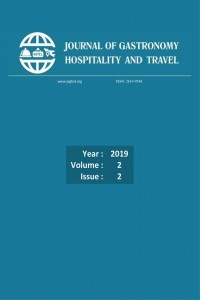Öz
Kaynakça
- Badri, S. A., Yari Hesar, A. (2009), Selection of Typical Tourism Regions Using AHP Method Case Study: Kohgiluyeh and Boyer Ahmad Province, Geographical Quarterly, 95, pp. 55-84.
- Bunruamkaew, K., Murayama, Y. (2012): Land Use and Natural Resources Planning for Sustainable Ecotourism Using GIS in Surat Thani, Thailand, Sustainability 2012, 4, 412-429; doi:10.3390/su4030412.
- Firoozi, M. A, Goodarzi, M., Z., Reza, A., A. (2013), Ecological Capacity Assessment of Shahid Abbaspour Dam Typical Tourism Region, Emphasizing Sustainable Tourism Development, Applied Geosciences Research (Geosciences), Thirteenth, No. 28, pp. 29-16.
- Jen, L., Jing,Y., Wang, Y., Shu-xia, Y. (2010): Environmental ImpactAssessment of Land use Planning in Wuhan City Based on Ecological Suitability Analysis, procedia Environmental Sciences, 2010, 2, 185- 191.
- Murayama Y.,Bunruamkaew K., (2011): "site suitability evaluation ecotourism using GIS and AHP "a case study ofsuratthanhi province, Thiland.procedia social and behavioral science,21:269-278.
- Parolo, G., Ferrarini, A. and Rossi, G. (2009) Optimization of Tourism Impacts Within Protected Area by Means of Genetic Algorithms, Journal of Springer, Vol. 14, pp. 25-41.
- Rahmani, M. F., Rasouli, S. H., Peyloor, A.A. (2014), Optimal Location of Ecotourism and Areas Susceptible to Tourism Development Using GIS (Case Study of Kalaleh), The First Congress of Urban Management and City Councils , Sari, Center for Development Conferences of Iran.
- Rezvani, M. R, Avaji, H., Alizadeh, M., Najafi, M. S. (2013), Locating the construction of ski trails in terms of tourism (Case study: Northern regions of Tehran province), Regional Planning Quarterly, No. 10, Pages 27 - 44.
- Sadr Mousavi, M, Daghili-e-Namvi, J. (2007), Assessment of the Situation of Tourist Facilities of East-Azarbaijan Province from the Point of View of Tourists, Geographical Research, No. 61, pp. 129-143.
- Scowsill, d., Travel & Tourism Economic impact, (2014): World Travel & Tourism Council Vol. 52.No 44-63.
- Silberman, J, W. Rees, P. (2010): Reinventing mountain settlements: A GIS model for identifying, possible ski towns in the U.S. Rocky Mountains, Elsevier, Applied Geography 30 (2010) 36–49.
- Zarbast, E. (2010), Application of Network Analysis Process (ANP) in Urban and Regional Planning, Zabiya Architecture, Architecture and Urban Development, No. 41, pp. 79-90.
- Zerabadi, Z. S. S., Abdollah, B. (2013), Evaluation of factors affecting the development of the tourism industry in Chabahar Free Zone, Using the Analytical Network Process (ANP) method, Iranian Scientific Society of Architecture and Urban Development, No. 6, Pages 37 - 48.
Öz
Eco-tourism is a purpose-oriented nature trip to understand the natural and cultural history of the environment by avoiding the change any ecosystems. Degradation of the environment and the creation of economic activities that lead to the proper exploitation of environmental resources and employment for indigenous people. Assessing the power of Lighvan-e Chai and Saeid Abadi watersheds for eco-tourism development is a major step taken in the sustainable development in the region. The present paper aims to assess the eco-tourism potential of the area using the ANP process and Geographic studies system (GIS). Based on the results of the eco-tourism capability map, %1.42 of the high level in the study area is 7.11% of the good level. Also, the results of this study showed that the most unsuitable areas for the construction of high-rise tourist villages were identified. More than 55% of the total range is included.
Anahtar Kelimeler
Eco-Tourism Potential Network Analysis (Anp) Gis Geographic Information System Saeedabad Basin and Lighvanchai
Kaynakça
- Badri, S. A., Yari Hesar, A. (2009), Selection of Typical Tourism Regions Using AHP Method Case Study: Kohgiluyeh and Boyer Ahmad Province, Geographical Quarterly, 95, pp. 55-84.
- Bunruamkaew, K., Murayama, Y. (2012): Land Use and Natural Resources Planning for Sustainable Ecotourism Using GIS in Surat Thani, Thailand, Sustainability 2012, 4, 412-429; doi:10.3390/su4030412.
- Firoozi, M. A, Goodarzi, M., Z., Reza, A., A. (2013), Ecological Capacity Assessment of Shahid Abbaspour Dam Typical Tourism Region, Emphasizing Sustainable Tourism Development, Applied Geosciences Research (Geosciences), Thirteenth, No. 28, pp. 29-16.
- Jen, L., Jing,Y., Wang, Y., Shu-xia, Y. (2010): Environmental ImpactAssessment of Land use Planning in Wuhan City Based on Ecological Suitability Analysis, procedia Environmental Sciences, 2010, 2, 185- 191.
- Murayama Y.,Bunruamkaew K., (2011): "site suitability evaluation ecotourism using GIS and AHP "a case study ofsuratthanhi province, Thiland.procedia social and behavioral science,21:269-278.
- Parolo, G., Ferrarini, A. and Rossi, G. (2009) Optimization of Tourism Impacts Within Protected Area by Means of Genetic Algorithms, Journal of Springer, Vol. 14, pp. 25-41.
- Rahmani, M. F., Rasouli, S. H., Peyloor, A.A. (2014), Optimal Location of Ecotourism and Areas Susceptible to Tourism Development Using GIS (Case Study of Kalaleh), The First Congress of Urban Management and City Councils , Sari, Center for Development Conferences of Iran.
- Rezvani, M. R, Avaji, H., Alizadeh, M., Najafi, M. S. (2013), Locating the construction of ski trails in terms of tourism (Case study: Northern regions of Tehran province), Regional Planning Quarterly, No. 10, Pages 27 - 44.
- Sadr Mousavi, M, Daghili-e-Namvi, J. (2007), Assessment of the Situation of Tourist Facilities of East-Azarbaijan Province from the Point of View of Tourists, Geographical Research, No. 61, pp. 129-143.
- Scowsill, d., Travel & Tourism Economic impact, (2014): World Travel & Tourism Council Vol. 52.No 44-63.
- Silberman, J, W. Rees, P. (2010): Reinventing mountain settlements: A GIS model for identifying, possible ski towns in the U.S. Rocky Mountains, Elsevier, Applied Geography 30 (2010) 36–49.
- Zarbast, E. (2010), Application of Network Analysis Process (ANP) in Urban and Regional Planning, Zabiya Architecture, Architecture and Urban Development, No. 41, pp. 79-90.
- Zerabadi, Z. S. S., Abdollah, B. (2013), Evaluation of factors affecting the development of the tourism industry in Chabahar Free Zone, Using the Analytical Network Process (ANP) method, Iranian Scientific Society of Architecture and Urban Development, No. 6, Pages 37 - 48.
Ayrıntılar
| Birincil Dil | İngilizce |
|---|---|
| Konular | Turizm (Diğer) |
| Bölüm | Makaleler |
| Yazarlar | |
| Yayımlanma Tarihi | 31 Aralık 2019 |
| Yayımlandığı Sayı | Yıl 2019 Cilt: 2 Sayı: 2 |


